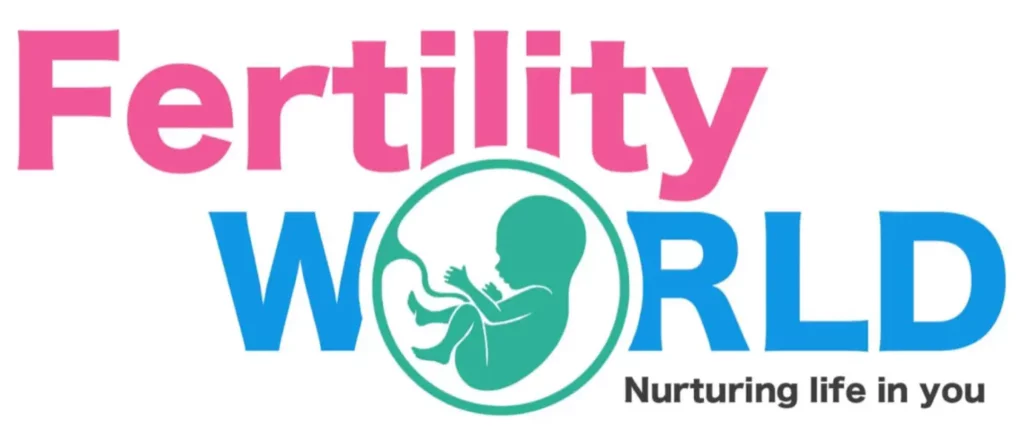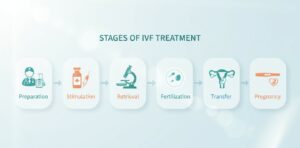For couples who have been trying to get pregnant for years and hope, pray, and try all possible ways, the decision to try IVF will often make them feel both hope and fear. You are not just looking for a medical process, but you’re looking for answers, clarity, and most importantly, a way to get the baby you’ve always dreamed of.You should know and understand what happens during each stage of IVF treatment, which will help you feel confident and in control instead of feeling unsure.
IVF (in vitro fertilisation) is not just one thing; it’s a meticulously planned journey of science, patience, and bravery. From the first injection to the moment you see that positive pregnancy test, every step is carefully planned to give you the best possible chance at parenthood. The IVF process step by step gives you actual remedies for problems that have made it hard to get pregnant naturally, like blocked fallopian tubes, male infertility, PCOS, endometriosis, or unexplained infertility.
At Fertility World, we have helped thousands of couples through this life-changing journey. This blog will guide you through the entire process of IVF, breaking down the process that starts from ovarian stimulation to embryo transfer, pregnancy confirmation, so you will know exactly what to expect at every stage.
IVF treatment can feel like the last chance for couples who have been trying for years, but it’s actually a very scientific and well-planned process that has real, measurable success. You’re not the only one who wants to know how IVF works. The good news is that it’s not so scary once you know how it all works.
What is IVF treatment? In simple terms, it’s a method of infertility treatment in which eggs are taken from a woman’s ovaries and mixed with sperm in a special lab. Embryos are made outside of the body and are then carefully put back into the uterus. This gives them the best chance to attach and grow into a safe pregnancy.
The step-by-step IVF process is made to help couples who are having problems like fallopian tubes that are blocked or damaged, sperm that don’t move or count well, PCOS (Polycystic Ovary Syndrome), endometriosis, or even infertility that can’t be explained even after tests. No matter what, the body sometimes just needs a little extra help to do its thing.
There are six key scientific stages in the IVF process that are all carefully watched over by fertility experts. From getting your ovaries to make more eggs, to picking them out at the right time, to fertilising them in the lab, to watching the embryos grow, to putting the best one into your uterus, and finally, the two-week wait that makes you nervous but hopeful.
Each step is important. You are getting closer with each step. Let’s go over them together.
Stage 1 – Pre-IVF Evaluation and Fertility Preparation
If you want to start IVF, your doctor needs to know more about your fertility. This is like making your own unique road map to pregnancy. Couples can get tests before they go through IVF to see what’s working, what needs more work, and how to give them the best chance of success. Both partners are part of this fertility test before IVF because it takes two to make a baby, and both sides of the issue are important.
Medical Screening Before IVF
To come up with the best treatment plan for you, a fertility expert will do a number of tests:
| Test | Purpose | Ideal Range for IVF |
|---|---|---|
| AMH / FSH | Measures ovarian reserve (egg supply) | AMH > 1.5 ng/ml |
| Semen Analysis | Checks sperm count & motility | >15 million/ml |
| HSG / Sonography | Examines tubes & uterus | Normal structure |
| Thyroid / Prolactin | Ensures hormonal balance | Normal levels |
Why it matters:
The AMH test tells your doctor how many eggs you might make with IVF. If ICSI (direct sperm injection) is needed, sperm screening before IVF is required. Hormones won’t stop pregnancy if you get a thyroid and prolactin test during IVF.
These aren’t just boxes to check; they’re like pieces of a puzzle that help your doctor make a treatment plan just for you.
Lifestyle and Diet Preparation
It’s not hard to get your body ready for IVF. Small changes that show you care can really improve the eggs and sperm quality and your chances of success.
IVF Diet Plan — What to Eat Before IVF:
- Protein: Eggs, paneer, lentils, chicken
- Iron & Folate: Spinach, beetroot, leafy greens
- Healthy fats: Nuts, avocados, seeds
- Fertility vitamins: Folic acid, Vitamin D, Omega-3 (ask your doctor)
Lifestyle Habits That Help:
- Get 7-8 hours of sleep as your body heals and balances hormones at night
- Limit caffeine to 1 cup/day or skip it
- Quit drinking and smoking; both hurt the health of your eggs and sperm.
- Stress management before IVF: Take a Walk, meditate, breathe. Your mental health matters just as much
- Drink 8-10 glasses of water daily.
You don’t need to be perfect. Just do your best. Be gentle with your body while it gets ready for something amazing to happen.
Stage 2 – Ovarian Stimulation and Follicle Monitoring
When you start getting those daily IVF injections, your IVF process will truly start. Many people are afraid of needles, but after doing this process, they find it much easier than they thought it would be. More than one good egg can be laid in a single cycle, so they are important.
Purpose of Ovarian Stimulation
You only release one egg every month in a natural pattern. Actually, that’s not enough for IVF because not every egg fertilises, and not every baby grows properly. So ovarian stimulation IVF is basically asking your ovaries, “Hey, instead of one egg this month, can we try for 8-15? In order to get pregnant, having more eggs increases the chances of making healthy babies.
Medications Used for Stimulation
In vitro fertilisation (IVF) uses FSH injections IVF shots to help follicles (egg sacs) grow. These are some common medications:
- Gonal-F or Menopur — used to stimulate egg growth
- Cetrotide or Ganirelix — prevent early ovulation
- Lupron — controls hormone surges in some protocols
IVF Protocols:
Antagonist Protocol is the most common type of IVF. Injections for 10-12 days. Most suitable for women with a healthy ovarian reserve. Agonist Protocol take a Longer process. It is used for PCOS or better hormone control.
Mini IVF is a Minimal medication that is used for low ovarian reserve.
Your protocol is customised for your body and is not random.
Follicle Growth and Monitoring
Your doctor tracks egg growth in the IVF cycle with follicle monitoring ultrasound, and blood tests every 2-3 days.
| Day of Cycle | What Happens | Hormone Checked |
|---|---|---|
| Day 2–3 | Start injections | Baseline E2, FSH |
| Day 6–8 | Follicles grow (visible on scan) | Rising E2 |
| Day 10–12 | Follicles 18-20mm — ready! | LH monitored |
To avoid overstimulation, your doctor checks the estrogen levels and the size of the follicle (ideally 18–20 mm for mature eggs). You may feel bloated or upset at this stage, but each scan brings you closer.
Stage 3 – Final Egg Maturation and Trigger Shot
With those daily shots for almost two weeks, you’ve been great. Your follicles are all set. The last and most important shot is now the trigger shot.
What is the trigger shot?
Your doctor will tell you it’s time for the trigger shot when your follicles get to 18 to 20 mm – usually an hCG injection or Lupron. “Time to finish maturing—we’re coming to get you in 36 hours!” This shot tells your eggs.
It’s called a “trigger” because it starts the last stage of egg development. You won’t be able to get your eggs without it.
Why time is so important
You’ll be told exactly when to take this shot. It’s usually between 9 and 10 PM. The egg retrieval takes place exactly 34 to 36 hours later.
No, I’m sorry. Your eggs need exactly 34-36 hours to mature after the trigger. Too early, and they’re not ready. Too late or missed? Your eggs might release on their own before retrieval — meaning empty follicles after all your effort.
“What if I forget or get the timing wrong?”
Call your clinic right away, even if it’s 2 AM. They can sometimes change the time it takes to get anything back, but they need to know right away. That’s why they say to set three alarms, write it down everywhere, and ask someone to remind you.
Stage 4 – Egg Retrieval Procedure (Ovum Pick-Up)
This is it — egg retrieval day! Today, your doctor will take the eggs you’ve been nurturing after all those shots. It’s reasonable to be scared, but the truth is that this day of IVF is brief and not as terrible as you imagine.
The Day of Egg Retrieval
“What really happens? Will it hurt?
Let’s go over it step by step:
Step 1: You come without eating or drinking anything for 6 hours before
Step 2: You have a light anaesthetic for IVF using an IV. You’ll be sleepy and at ease; most women don’t even remember the treatment!
Step 3: The doctor uses ultrasonography to carefully guide a small needle through the vaginal wall into each follicle and suck out the fluid (and egg) into collection tubes.
“Wait, through the wall of the vagina? That sounds like it hurts!
It would be if you weren’t relaxed. Otherwise, you won’t even notice it. Some women will feel a little pressure afterwards, but not during the process.
Step 4: The embryologist looks at each tube under a microscope to find and count your eggs. Your partner might even see this on a screen!
Step 5: The whole thing just takes 15 to 30 minutes. You rest for two hours, then you go home (someone has to drive you).
Post-Egg Retrieval Care
“How will I feel after? Can I go back to work?“
Most women feel well, but they could be a little sleepy and have cramps like they do after their period. Here is what is normal:
- Mild cramps
- Bloating (ovaries are still bloated)
- Light spotting
- Feeling fatigued or emotional
Stage 5 – Fertilization and Embryo Culture
Your eggs are out! This part is really interesting, but you can’t see it as the IVF fertilization process happens in the lab when you are resting at home.
IVF vs. ICSI: “How does fertilization actually happen?”
There are two methods:
| Method | How It’s Done | Ideal For |
|---|---|---|
| Conventional IVF | Eggs and sperm placed together in a dish to fertilize naturally | Normal sperm quality |
| ICSI | Single sperm injected directly into each egg | Low sperm count or poor motility |
“So, Which one is better?” No, they are just different things. You can do regular IVF, which works great if the sperm is healthy. And the ICSI procedure will help when there’s male infertility. There is a use of about 60-70% of ICSI in an IVF cycle.
You will find out how many were fertilized on the next day. Usually, 70–80% of them are fertilised, and not every egg will be, and that’s okay.
Embryo Development Stages
“What will happen to my embryos in the next few days?”
Your embryos grow in special incubators that look like your body. This is the timeline:
| Day | Embryo Stage | What’s Happening |
|---|---|---|
| Day 1 | Fertilization | Two pronuclei visible — fertilization confirmed! |
| Day 2–3 | Cleavage stage | Embryo divides into 6-8 cells |
| Day 5 | Blastocyst | 100+ cells — best stage for transfer or freezing |
You’ve finally reached the moment you’ve been waiting for: the transfer of the embryo! This is the time when the embryo is put back into your uterus. It’s emotional, hopeful, and to be honest? Not as hard as you think.
How Embryo Transfer Is Done
“Is embryo transfer painful? Will I need anaesthesia?”
Here’s the best part: Embryo transfer IVF is one of the easiest steps. No pain, no sedation, no anaesthetic. It’s like a pap smear that takes a little longer.
- Timing: The transfer happens three to five days after the egg retrieval (day 5 blastocyst transfer).
- Painless: Most women feel moderate pressure and are awake the whole time.
- Guided by ultrasound: The doctor utilises ultrasound (you’ll need a full bladder!) to guide a thin catheter into your cervix.
- The miraculous moment: The embryo(s) are softly released into your uterus. You might see a small white light on the screen!
- Fast: It takes 5 to 10 minutes, then you rest for a short time before going home. “Do I need to rest in bed after?” Nope! It’s a Myth from the past. You can get back to your everyday life. For a few days, don’t lift heavy things or work out hard.
Stage 7 – The Two-Week Wait and Pregnancy Confirmation
The two-week wait for IVF is the longest 14 days of your life. This is the time between the transfer and the pregnancy test that comes after the embryo transfer. Hope, worry, and the urge to find symptoms are coming up!
What Happens After Transfer
“What’s my embryo doing right now?”
Days 1–2: The embryo floats and grows.
Days 3–5: The embryo hatches from its shell and searches for the right place.
Days 6–10: The embryo implants! The embryo digs into the lining of your uterus. The real start of pregnancy.
You’ll continue progesterone support (suppositories, injections, or pills) to keep your lining thick and ready.
Pregnancy Test (Beta-hCG)
“When can I take a test?”
| Day After Transfer | Test | Purpose |
|---|---|---|
| Day 9-14 | β-hCG blood test | Confirms pregnancy (hCG > 50) |
| Day 14-21 | Second β-hCG | Should double every 48-72 hours |
| Week 6-7 | Ultrasound | Confirms heartbeat! |
Can I take a home test? Yes, but it’s dangerous. Testing before day 10 often gives false negatives because the hCG level isn’t high enough yet. If you can’t wait, test day 10 or later with a sensitive test. A negative result doesn’t indicate it’s over.
Common Symptoms of Pregnancy After IVF
“Am I pregnant? I’m cramping and bloating!“
The truth is that implantation symptoms, IVF, and progesterone side effects feel the same.
You might feel:
- Some mild cramps
- Bloating
- Sore breasts
- Tiredness
- Light spotting
But these are mostly caused by progesterone, not by being pregnant. Some ladies are pregnant and don’t have any signs. Some people have all the symptoms and aren’t pregnant. Symptoms aren’t always good at predicting things.
IVF Success Rate and Factors Affecting It
“What are my chances of IVF? Will IVF work for me?“
This is the first thing everyone asks. The truth? IVF success rate by age depends, and every journey is different. But let’s get down to numbers.
| Age Group | Average Success Rate Per Cycle |
|---|---|
| Under 30 years | 55–60% |
| 30–35 years | 45–50% |
| 36–40 years | 30–40% |
| Over 40 years | 15–25% |
“I’m more than 35 years old. Does that mean I can’t get pregnant?”
Not at all! These are the averages. Many women who are over 35 and even 45 have successful IVF pregnancies. Success is definitely possible, even if it takes more than one cycle. Because your doctor learns and changes, the success rates for the second cycle of IVF generally go up.
Even a 30% chance means 3 out of 10 women succeed. That’s real hope.
Final Thoughts — IVF Is a Journey of Science, Strength, and Hope
IVF isn’t only a medical procedure you go through. It’s an emotional journey through IVF that includes bravery, vulnerability, tears at night, and quiet prayers. It’s waking up every day and choosing hope, even when you’re tired. It’s trusting science while your heart is broken. You have to believe that your baby is worth every shot, every appointment, and every second of waiting.
In fact, IVF treatment in India has helped thousands of couples have the babies they thought they would never have.
Someone just like you was afraid, unsure, and desperately hopeful behind every IVF success story. And a lot of them are now parents. They look back on their IVF journey as the hardest and most beautiful thing they have ever accomplished.
You don’t need to go this way by yourself. We know that IVF treatment is more than just embryos and hormones at Fertility World IVF centre. It’s about your dream of having a child. Our team offers expertly led fertility care with IVF plans that are made just for YOUR body, YOUR situation, and YOUR story. From your first appointment to the moment you find out you’re pregnant, we’re with you the whole way.
Science can make magic happen. Hope can make things happen. What about you? You’re better than you think.
Taking the first step toward becoming a parent is all it takes. Let’s do it together.



